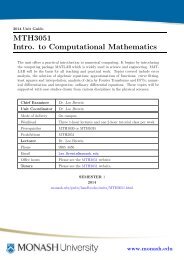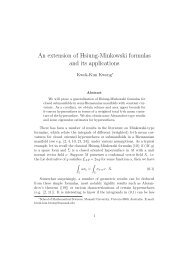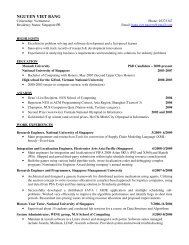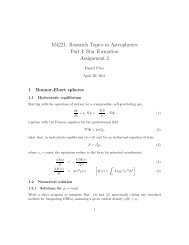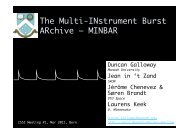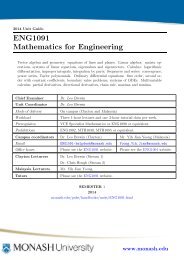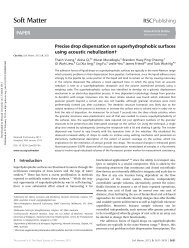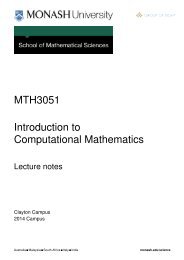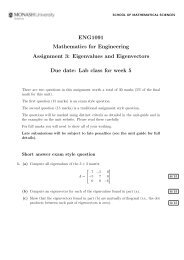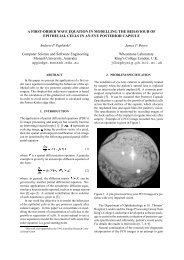Intersection theory on moduli spaces of curves ... - User Web Pages
Intersection theory on moduli spaces of curves ... - User Web Pages
Intersection theory on moduli spaces of curves ... - User Web Pages
You also want an ePaper? Increase the reach of your titles
YUMPU automatically turns print PDFs into web optimized ePapers that Google loves.
iAbstractThis thesis explores the intersecti<strong>on</strong> <str<strong>on</strong>g>theory</str<strong>on</strong>g> <strong>on</strong> M g,n , the <strong>moduli</strong> space <strong>of</strong> genus g stable <strong>curves</strong>with n marked points. Our approach will be via hyperbolic geometry and our starting pointwill be the recent work <strong>of</strong> Mirzakhani.One <strong>of</strong> the landmark results c<strong>on</strong>cerning the intersecti<strong>on</strong> <str<strong>on</strong>g>theory</str<strong>on</strong>g> <strong>on</strong> M g,n is Witten’s c<strong>on</strong>jecture.K<strong>on</strong>tsevich was the first to provide a pro<strong>of</strong>, the crux <strong>of</strong> which is a formula involving combinatorialobjects known as ribb<strong>on</strong> graphs. A subsequent pro<strong>of</strong>, due to Mirzakhani, arises fromc<strong>on</strong>sidering M g,n (L), the <strong>moduli</strong> space <strong>of</strong> genus g hyperbolic surfaces with n marked geodesicboundaries whose lengths are prescribed by L = (L 1 , L 2 , . . . , L n ). Through the Weil–Peterss<strong>on</strong>symplectic structure <strong>on</strong> this space, <strong>on</strong>e can associate to it a volume V g,n (L). Mirzakhani produceda recursi<strong>on</strong> which can be used to effectively calculate these volumes. Furthermore, sheproved that V g,n (L) is a polynomial whose coefficients store intersecti<strong>on</strong> numbers <strong>on</strong> M g,n .Her work allows us to adopt the philosophy that any meaningful statement about the volumeV g,n (L) gives a meaningful statement about the intersecti<strong>on</strong> <str<strong>on</strong>g>theory</str<strong>on</strong>g> <strong>on</strong> M g,n , and vice versa.Two new results, known as the generalised string and dilat<strong>on</strong> equati<strong>on</strong>s, are introduced inthis thesis. These take the form <strong>of</strong> relati<strong>on</strong>s between the Weil–Peterss<strong>on</strong> volumes V g,n (L) andV g,n+1 (L, L n+1 ). Two distinct pro<strong>of</strong>s are supplied — <strong>on</strong>e arising from algebraic geometry andthe other from Mirzakhani’s recursi<strong>on</strong>. However, the particular form <strong>of</strong> the generalised stringand dilat<strong>on</strong> equati<strong>on</strong>s is highly suggestive <strong>of</strong> a third pro<strong>of</strong>, using the geometry <strong>of</strong> hyperbolicc<strong>on</strong>e surfaces. We briefly discuss ideas related to such an approach, although this largely remainswork in progress. Applicati<strong>on</strong>s <strong>of</strong> these relati<strong>on</strong>s include fast, effective algorithms tocalculate the Weil–Peterss<strong>on</strong> volumes in genus 0 and 1. We also deduce a formula for the volumeV g,0 , a case not dealt with by Mirzakhani.In this thesis, we also give a new pro<strong>of</strong> <strong>of</strong> K<strong>on</strong>tsevich’s combinatorial formula, relating the intersecti<strong>on</strong><str<strong>on</strong>g>theory</str<strong>on</strong>g> <strong>on</strong> M g,n to the combinatorics <strong>of</strong> ribb<strong>on</strong> graphs. Mirzakhani’s theorem suggeststhat the asymptotics <strong>of</strong> V g,n (L) store valuable informati<strong>on</strong>. We dem<strong>on</strong>strate that this informati<strong>on</strong>is precisely K<strong>on</strong>tsevich’s combinatorial formula. Our pro<strong>of</strong> involves using hyperbolic geometryto develop a combinatorial model for M g,n (L) and to analyse the asymptotic behaviour<strong>of</strong> the Weil–Peterss<strong>on</strong> symplectic form. The key geometric intuiti<strong>on</strong> involved is the fact that, asthe boundary lengths <strong>of</strong> a hyperbolic surface approach infinity, the surface resembles a ribb<strong>on</strong>graph after appropriate rescaling <strong>of</strong> the metric. This work draws together K<strong>on</strong>tsevich’s combinatorialapproach and Mirzakhani’s hyperbolic approach to Witten’s c<strong>on</strong>jecture into a coherentnarrative.



